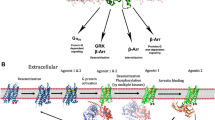Abstract
Molecular dynamics simulations of the biphalin molecule, (Tyr-D-Ala-Gly-Phe-NH)2, and the active tetrapeptide hydrazide, Tyr-D-Ala-Gly-Phe-NH-NH2 were performed to investigate the cause of the increased μ and δ receptor binding affinities of the former over the latter. The simulation results demonstrate that the acylation of the two equal tetrapeptide fragments of biphalin produces the constrained hydrazide bridges \( {\hbox{C}}_4^{\alpha } - {{\hbox{C}}_4}\prime - {{\hbox{N}}_9} - {{\hbox{N}}_{{10}}} \) and \( {{\hbox{N}}_9} - {{\hbox{N}}_{{10}}} - {{\hbox{C}}_5}\prime - {\hbox{C}}_5^{\alpha } \), which in turn increase the opportunity of conformations for binding to μ or δ receptors. Meanwhile, the connection of the two active tetrapeptide fragments of biphalin also results in the constrained side chain torsion angle χ2 at one of the two residues Phe. This constrained side chain torsion angle not only significantly increases the δ receptor binding affinity but also makes most of the δ receptor binding conformations of biphalin bind to the δ receptor through the fragment containing the mentioned residue Phe.








Similar content being viewed by others

References
Egan TM, North RA (1981) Both mu and delta opiate receptors exist on the same neuron. Science 214:923–924
Rapaka RS, Porreca F (1991) Development of delta opioid peptides as nonaddicting analgesics. Pharm Res 8:1–8
Traynor JR, Elliott J (1993) Delta-opioid receptor subtypes and cross-talk with mu-receptors. Trends Pharmacol Sci 14:84–86
Jordan BA, Cvejic S, Devi LA (2000) Opioids and their complicated receptor complexes. Neuropsychopharmacology 23:S5–S18
Ananthan S (2006) Opioid ligands with mixed mu/delta opioid receptor interactions: an emerging approach to novel analgesics. AAPS J 8:E118–E125
Lipkowski AW, Konecka AM, Sroczynska I (1982) Double-enkephalin-synthesis, activity on guinea-pig ileum, and analgesic effect. Peptides 3:697–700
Misicka A, Lipkowski AW, Horvath R, Davis P, Porreca F, Yamamura HI, Hruby VJ (1994) Delta-opioid receptor selective ligands; DPLPE-deltorphin chimeric peptide analogues. Int J Pept Protein Res 44:80–84
Abbruscato TJ, Williams SA, Misicka A, Lipkowski AW, Hruby VJ, Davis TP (1996) Blood- to- central nervous system entry and stability of biphalin, a unique double-enkephalin analog, and its halogenated derivatives. J Pharmacol Exp Ther 276:1049–1057
Abbruscato TJ, Thomas SA, Hruby VJ, Davis TP (1997) Brain and spinal cord distribution of biphalin: correlation with opioid receptor density and mechanism of CNS entry. J Neurochem 69:1236–1245
Shimohigashi Y, Costa T, Chen HC, Rodbard D (1982) Dimeric tetrapeptide enkephalins display extraordinary selectivity for the delta opiate receptor. Nature 297:333–335
Misicka A, Lipkowski AW, Horvath R, Davis P, Porreca F, Yamamura HI, Hruby VJ (1997) Structure-activity relationship of biphalin: the synthesis and biological activities of new analogues with modifications in position 3 and 4. Life Sci 60:1263–1269
Silbert BS, Lipkowski AW, Cepeda MS, Szyfelbein SK, Osgood PF, Carr DB (1991) Analgesic activity of a novel bivalent opioid peptide compared to morphine via different routes of administration. Agents Actions 33:382–387
Horan PJ, Mattia A, Bilsky EJ, Weber S, Davis TP, Yamamura HI, Malatynska E, Appleyard SM, Slaninova J, Misicka A, Lipkowski AW, Hruby VJ, Porreca F (1993) Antinociceptive profile of biphalin, a dimeric enkephalin analog. J Pharmacol Exp Ther 265:1446–1454
Yamazaki T, Ro S, Goodman M, Chung NN, Schiller PW (1993) A topochemical approach to explain morphiceptin bioactivity. J Med Chem 36:708–719
Shenderovich MD, Liao S, Qian X, Hruby VJ (2000) A three-dimensional model of the delta-opioid pharmacophore: comparative molecular modeling of peptide and nonpeptide ligands. Biopolymers 53:565–580
Lindahl E, Hess B, van der Spoel D (2001) GROMACS 3.0: a package for molecular simulation and trajectory analysis. J Mol Model 7:306–317
Scott WRP, Hunenberger PH, Tironi IG, Mark AE, Billeter SR, Fennen J, Torda AE, Huber T, Kruger P, van Gunsteren WF (1999) The GROMOS biomolecular simulation program package. J Phys Chem A 103:3596–3607
Flippen-Anderson JL, Deschamps JR, George C, Hruby VJ, Misicka A, Lipkowski AW (2002) Crystal structure of biphalin sulfate: a multireceptor opioid peptide. J Peptide Res 59:123–133
Berendsen HJC, Postma JPM, van Gunsteren WF, Di Nola A, Haak JR (1984) Molecular dynamics with coupling to an external bath. J Chem Phys 81:3684–3690
Darden T, York D, Pedersen L (1993) Particle mesh Ewald—an N∙Log(N) method for Ewald sums in large systems. J Chem Phys 98:10089–10092
Lipkowski AW, Misicka A, Davis P, Stropova D, Janders J, Lachwa M, Porreca F, Yamamura HI, Hruby VJ (1999) Biological activity of fragments of the potent dimeric opioid peptide, biphalin. Bioorg Med Chem Lett 9:2763–2766
Acknowledgments
The authors gratefully acknowledge the support provided to this research by the National Science Council, Taiwan, under Grant Nos. 96-2628-E-159-001-MY3
Author information
Authors and Affiliations
Corresponding author
Rights and permissions
About this article
Cite this article
Hsieh, JY., Chiang, TY., Chen, JL. et al. A molecular dynamics study on opioid activities of biphalin molecule. J Mol Model 17, 2455–2464 (2011). https://doi.org/10.1007/s00894-010-0931-1
Received:
Accepted:
Published:
Issue Date:
DOI: https://doi.org/10.1007/s00894-010-0931-1



